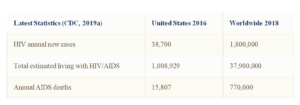Outcomes
This 1-hour course will inform healthcare professionals about the latest information and treatment for human immunodeficiency virus (HIV) and acquired immune deficiency syndrome (AIDS). After taking the course, you will be able to explain HIV/AIDS, how it’s transmitted and how it impacts the immune system. You will also be able to discuss preventing transmission of the virus, prevention and treatment among children, and the most current treatments available.
Objectives
After completing this course, the learner will be able to:
• Identify the civil rights of the HIV/AIDS-infected individual and their family/friends
• Relate the mechanism of action of HIV as an infectious agent
• Describe the pathophysiologic changes in the human body following HIV infection
• Describe the modes of transmission of HIV and various strategies to prevent the spread of HIV
• Examine informed consent relating to HIV
• Compare and contrast current medications modalities prescribed for the HIV-infected individual
The prospect of having HIV can provoke fear and dread. This anxiety is reasonable given the history surrounding HIV and AIDS in the United States and globally. HIV infection is a very serious medical condition, though not quite the sentence of an agonizing wasting death that it was during the 1980s and 1990s. There are now medications that can slow the progression of the disease by decades in many cases, giving a new quality of life to those diagnosed rather than the specter of a wasting, suffering death.
The question remains as to why so many in the United States avoid HIV testing when it is so important to become aware of infection early, to begin treatment, and slow or avoid the fate they see portrayed by the news media visiting impoverished AIDS-stricken countries in Africa’s west, central and southern regions. Perhaps it is the fear of receiving a diagnosis with a fatal infectious disease or the fear of living with the responsibility of keeping a demanding disease such as HIV/AIDS under control. Keeping HIV under control is a time and resource-consuming task. However, the option of letting the disease run its course unchecked would be a very poor choice, as well.
Whatever factor(s) bring hesitation to those needing HIV prevention counseling, screening, or treatment, we know that one commonly held fear is the stigma attached to having HIV or AIDS. Having HIV brings a “scarlet letter” fear of repercussions due to possessing an unwanted health status. When questioned, many of those newly diagnosed with HIV seem unaware that federal laws exist to protect them from discrimination and ensure that benefits such as any social or medical services they would qualify for will not be withheld. As healthcare professionals, it is important to share with those in high-risk groups that key legislation pieces exist that offer protection from discrimination. Interestingly, some of the mandates and pieces of legislation protecting those with current needs predate the HIV/AIDS epidemic, e.g., Section 504 of the Rehabilitation Act of 1973 and pieces of the 1990 Americans with Disabilities Act (ADA). These well-established laws mean services that apply to an otherwise qualified individual will also be available to HIV-infected individuals.
Title II of the ADA prohibits discrimination by state and local government organizations, even those not dependent on federal funding. For those nervous or fearful concerning how those close to them might be treated should they acquire HIV, Title II of the ADA also protects an HIV positive individual’s friends and family against discrimination or denial of services that might come from being related to someone with HIV (HIV.gov, 2017).
Information privacy regarding an individual’s HIV status is guaranteed by the 1996 Health Insurance Portability and Accountability Act (HIPAA), whose Privacy Rule is enforced by the Office for Civil Rights (OCR). HIPAA protects the privacy of health information while allowing each individual access to their records to see what is written about them and even ask to make corrections to what is documented.
Awareness of their individual rights and the value that each life inherently possesses are crucial foundational steps leading to the inclusion of those suffering from HIV into society and better health. By emphasizing the importance of each individual’s life, we, as healthcare professionals, can increase participation of the HIV infected individual in their own care by educating them to:
• Keep informed of any changes in HIV knowledge and care
• Use measures to stop the transmission of HIV
• Avoid high-risk behaviors
• Have routine screening for HIV infection, if necessary
• Actively participate in treatment should the individual become infected
Therefore, as we progress to viewing the magnitude of the current HIV pandemic with its slowly widening reach into our culture and homes, remember that we are really dealing with the frightened and wounded. Each is faced with the sudden overwhelming burden of managing the chronic terminal condition of HIV/AIDS.

Curriculum
- 1 Section
- 26 Lessons
- 10 Weeks
- Start Courese27
- 1.1Impact of HIV and AIDS30 Minutes
- 1.2Transmission and Prevention of HIV Infection
- 1.3HIV Sexual Transmission
- 1.4HIV Blood Transmission
- 1.5Pre-Exposure Prophylaxis (PrEP)
- 1.6Post-Exposure Prophylaxis (PEP)
- 1.7The Virus HIV
- 1.8HIV Virus Spreading through System
- 1.9Three Stages of HIV Infection
- 1.10HIV Primary or Acute Infection
- 1.11Chronic HIV or Asymptomatic Infection
- 1.12HIV as AIDS the Final Stage of Infection
- 1.13Diagnostic Tests for HIV
- 1.14HIV Antibody Tests
- 1.15HIV Antigen/Antibody Tests
- 1.16HIV Nucleic Acid (RNA) Tests
- 1.17HIV Testing Informed Consent
- 1.18HIV Test Results
- 1.19Positive HIV Results
- 1.20Indeterminate HIV Results
- 1.21HIV Viral Load Testing
- 1.22HIV Treatment
- 1.23HIV Medication Combination Therapies
- 1.24Case Study
- 1.25Summary
- 1.26References
- 1.28Questions10 Minutes10 Questions





